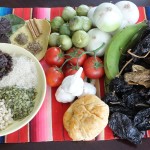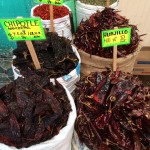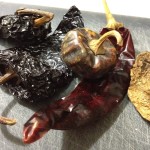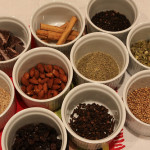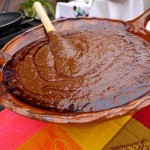Well here it goes, I have contemplated this subject for some time. I have been asking friends and relatives for their recipe and what it comes down to is that everyone makes this dish just a little bit differently. I was actually a little concerned about this topic. Concerned enough to ponder it for some time then place it on a shelf to consider it more, only to lose the research into a little corner of my office, and if you have ever seen my office you would know that that is pretty easy to do. I have to confess, I am actually NOT a big fan of this dish. Though I personally think that is due to the dish rarely being made correctly. This is not something you would just assemble for a quick dinner. It takes time, planning and a lot of prep (mise en place). The sauce has deep roots in Mexico, the name “Mole” (it is pronounced MOH/leh which sounds a little like olé and it might also rhyme with café but at NO time should it sound like you are referring to the small burrowing mammal that you sometimes find in your yard) comes from the Aztec word Mōlli which means sauce.
Many people mistakenly think there is only one mole, “Mole Poblano” which is the most commonly known dish from the Mexican state of Puebla. This dish is going to take a LONG time to prep – 6 to 8 hours – so it is best to do this in stages. There are the green moles using tomatillos, with springs of fresh coriander, green chilies, nuts or pumpkin seeds. Oaxaca has 7 moles that range in color from spring green to yellow, rust and black.
- ingrediants
- More chili
- Chili
- spices
- The sauce
- cooking
The cooking technique in making mole is similar to making an Indian curry. The ingredients—chilies, tomatoes, nuts, herbs and spices—are all ground to a coarse paste. Another thing to keep in mind is the mole paste has to be cooked in fat, otherwise the chilies will not blend with the other ingredients. The trick, I think, is to lower the heat as soon as the mixture is in the skillet and begin stirring.
All moles are thickened with nuts and seeds, but they don’t all have chocolate. The best versions do, I think, but the chocolate is only used in small proportions. If you use chocolate try to use Mexican chocolate, which is made with sugar, cinnamon, almonds and vanilla. If you cannot find Mexican chocolate use unsweetened cocoa, but only 1/3 of the volume.
Another fact I discovered is that moles in Mexico are normally made with turkey, not chicken. There is no rule that you must use turkey; any protein can be used, even duck, pork or beef. The only thing to remember is to not overcook your meat. If you use turkey I would not go any higher than 160° as you don’t want it dry, and the carry over cooking will finish the turkey to a moist bird.
The traditional mole poblano must have the correct chilies, mulato, ancho, and pasilla—all three are essential. Mulato chile distinguishes mole poblano from other moles. It offers a slightly anisey tartness. Ancho is a common dried chili and it gives the sauce an earthy and fruity flavor while providing a mild to medium heat. Please take note that the mulato and ancho look almost identical. The ancho is reddish and somewhat translucent, while the mulato is almost opaque-black brown. The pasilla will give depth to the sauce. This chili is sometime labeled chile negro or chile pasilla mexicano. The optional chipotle chilies will add smokiness and more heat. A chipotle is simply a smoke dried jalapeño.
Lard—I know what you’re thinking—but I have read that browning the lard plays an important role in the final flavor. This does not mean the mole will be heavy or greasy, but if lard is not for you, vegetable oil is a good substitute. Whichever fat you use, just be sure to skim any that remains from the surface of the sauce.
Another important piece of information: the blender is the best for puréeing the mole, not a food processor. If you were going to go old school you would ground on a metate (a flat stone used for milling grains and making mole sauce), but I would not even contemplate that task. The blender will make a smoother sauce, the blades in a blender move faster than a processor. You will need to strain the sauce. The consistency should be like a heavy cream.
A mortar and pestle or spice grinder should be used to pulverize the peppercorns, cloves, anise and cinnamon stick. I use a coffee grinder, it works great for this technique.
This dish will take a lot of time and energy to make correctly but I think it would be worth it to try it out for your family or friends for a special event or a Sunday family dinner. I am going to post the recipe on the Local Happenings website since we do not have the room here. So, if you want to take up the challenge please look for it online there. I will suggest that you break up the preparation into three days. I have read and been told the sauce is always better (as many sauces tend to be) the second day.
We are so fortunate to have a great many Mexican markets in our area that you should be able to find everything you need. Happy Cooking!
MOLE POBLANO RECIPE
16 Medium Dried Mulato Chiles (about 8 oz)
5 medium dried ancho chiles (about 2 ½ oz)
6 dried pasilla chiles (about 2 oz)
3/ 4 cup lard or vegetable oil
1 large ripe tomato, roasted or broiled until the skin is lightly blackened, peeled, and cored or ¾ of a 15 oz can or whole peeled tomatoes, well drained
2oz Mexican chocolate, roughly chopped or 2/3 oz unsweetened cocoa
10 black peppercorns (or a scant ¼ tsp. ground)
4 cloves
½ tsp. aniseed
1” piece cinnamon stick or about 1 tsp. ground
¼ cup sesame seeds
½ tsp. coriander seeds
Heaping 1/3 cup of unskinned almonds
1/3 cup of raisins
½ medium onion (sliced)
2 cloves of garlic, peeled
1 stale corn tortilla
2 pieces of stale white bread
1 canned chipotle chile, seeded
About 2 ½ qt. turkey broth
10 to 12 lb turkey (or chicken)
About 2 tsp. of salt
About ¼ cup sugar
Stem seed and devein the dried chiles, reserving 2 tsps. of the seeds. Tear the chiles into large pieces
Heat ¼ cup of the lard or oil in a large pan. When hot fry a few of the chiles, for several second until they turn nut brown. Transfer them to a large bowl, letting as much fat as possible drain back into pan. Cover the chiles with soiling water, weight them down to keep them submerged, soak at least 1 hour, and drain.
In a large bowl, break up the tomato with the back of the spoon. Add the chocolate to the tomato.
With a mortar and pestle or a spice grinder, pulverize the peppercorns, cloves, aniseed, and cinnamon stick. Add to the tomato mixture.
In a dry skillet set over medium heat, toast the sesame, coriander, and reserved chile seeds, one kind at a time, stirring until lightly browned. Add to the tomato mixture.
Heat another ¼ cup of the lard or oil in the skillet. Add the almonds, and stir frequently until browned, about 4 minutes. Remove draining well and add to the tomato mixture. Add the raisins to the hot oil and fry stirring constantly until they puff. Drain well and add to the tomato mixture
Add the onion and garlic to the hot fat and cook over medium heat, stirring frequently until browned 8 to 9 minutes. Press on them to drain the excess fat and transfer to the tomato mixture.
If necessary add a little more fat to the pan then fry the tortilla until browned, break it up and add to the mixing bowl. Add the bread to the pan, quickly flip it over to coat both sides with fat, then brown it on both sides. Tear into large pieces and add to the tomato mixture.
Puree the drained chiles and the chipotle. Work in three batches and add just enough broth to keep everything moving, about ¼ cup. Pulsing with help. Strain the purée through a medium sieve to remove skin and seeds. Puree the tomato mixture the same way. Set aside the two purees separately.
Heat another ¼ cup of fat in a large pot. Pat the turkey pieces dry with a paper towels, brown in the hot fat, 3 to 4 minutes per side. Transfer the browned turkey pieces to a roasting pan.
With the same large pot pour off excess fat leaving just enough to coat the bottom of the pan. Set over medium heat, add the chile puree, it should sear when it hits the pot. For smoothness, it must concentrate to a past stir constantly until the puree darkens and is very thick, about 5 minutes. Next the tomato mixture stir for several minutes until everything thickens again.
Stir in 5 cups of broth until smooth partially cover reduce the heat to low and let simmer gently, stirring occasionally about 45 minutes. Taste and add salt and sugar as needed. The sauce should be the consistency of heavy cream. If it’s too thick thin it with a little broth.
Heat the oven to 325 pour the sauce over the turkey in the roasting pan and back until the turkey is tender but moist about 150. Remove the turkey from the pan spoon off any accumulated fat, taste sauce and reseason with salt and sugar.
When the turkey is cooled skin each piece and cut the meat from the bone in large pieces. Arrange the meat on heatproof serving dishes.
Before serving pour the sauce over the turkey, cover and heat in a 350 oven for about 15 or 20 minutes, sprinkle with sesame seed and serve.
By Chef K. Marie Paulk

